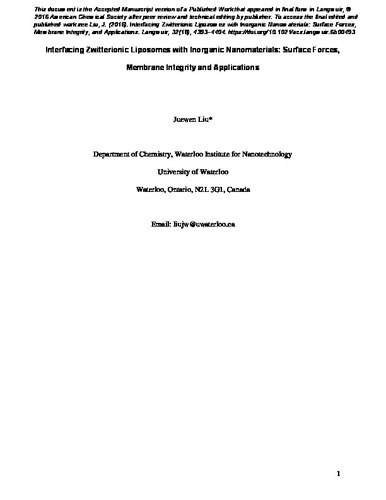| dc.contributor.author | Liu, Juewen | |
| dc.date.accessioned | 2017-04-28 16:11:57 (GMT) | |
| dc.date.available | 2017-04-28 16:11:57 (GMT) | |
| dc.date.issued | 2016-05-10 | |
| dc.identifier.uri | http://dx.doi.org/10.1021/acs.langmuir.6b00493 | |
| dc.identifier.uri | http://hdl.handle.net/10012/11788 | |
| dc.description | This document is the Accepted Manuscript version of a Published Work that appeared in final form in Langmuir, © 2016 American Chemical Society after peer review and technical editing by publisher. To access the final edited and published work see Liu, J. (2016). Interfacing Zwitterionic Liposomes with Inorganic Nanomaterials: Surface Forces, Membrane Integrity, and Applications. Langmuir, 32(18), 4393–4404. https://doi.org/10.1021/acs.langmuir.6b00493 | en |
| dc.description.abstract | Zwitterionic phosphocholine (PC) lipids are the main constituent of the mammalian cell membrane. PC bilayers are known for their antifouling properties, yet they are adsorbed by all tested inorganic nanoparticles. This feature article is focused on the developments in my laboratory in the past few years on this topic. The main experimental techniques include fluorescence-based liposome leakage assays, adsorption and desorption, and cryo-TEM. Different materials interact with PC liposomes differently. PC liposomes adsorb on SiO2, followed by membrane fusion with the surface forming supported lipid bilayers. TiO2 and other metal oxides adsorb only intact PC liposomes via lipid phosphate bonding; the steric effect from the choline group hinders subsequent liposome fusion onto the particles. Citrate-capped AuNPs are adsorbed very strongly via van der Wags forces, inducing local gelation. The result is transient liposome leakage upon AuNP adsorption or desorption and AuNP aggregation on the liposome surface. All carbon-based nanomaterials (graphene oxides, carbon nanotubes, and nanodiamond) are adsorbed mainly via hydrogen bonding. The oxidation level of graphene oxide strongly influences the outcome of the final hybrid material. In the context of inorganic nanoparticle adsorption, insights are given regarding the lack of protein adsorption by PC bilayers. These inorganic/lipid hybrid materials can be used for controlled release, drug delivery, and fundamental studies. A few examples of application are covered toward the end, and future perspectives are given. | en |
| dc.description.sponsorship | University of Waterloo; Canada Foundation for Innovation (CFI),; Natural Sciences and Engineering Research Council of Canada (NSERC) | en |
| dc.language.iso | en | en |
| dc.publisher | American Chemical Society | en |
| dc.subject | Supported Lipid-Bilayers | en |
| dc.subject | Induced Content Release | en |
| dc.subject | Gold Nanoparticles | en |
| dc.subject | Graphene Oxide | en |
| dc.subject | Phospholipid-Bilayers | en |
| dc.subject | Silica Nanoparticles | en |
| dc.subject | Vesicle Adsorption | en |
| dc.subject | Delivery Vehicles | en |
| dc.subject | Titanium-Dioxide | en |
| dc.subject | Phase-Transition | en |
| dc.title | Interfacing Zwitterionic Liposomes with Inorganic Nanomaterials: Surface Forces, Membrane Integrity, and Applications | en |
| dc.type | Article | en |
| dcterms.bibliographicCitation | Liu, J. (2016). Interfacing Zwitterionic Liposomes with Inorganic Nanomaterials: Surface Forces, Membrane Integrity, and Applications. Langmuir, 32(18), 4393–4404. https://doi.org/10.1021/acs.langmuir.6b00493 | en |
| uws.contributor.affiliation1 | Faculty of Science | en |
| uws.contributor.affiliation2 | Chemistry | en |
| uws.contributor.affiliation3 | Waterloo Institute for Nanotechnology (WIN) | en |
| uws.typeOfResource | Text | en |
| uws.peerReviewStatus | Reviewed | en |
| uws.scholarLevel | Faculty | en |

